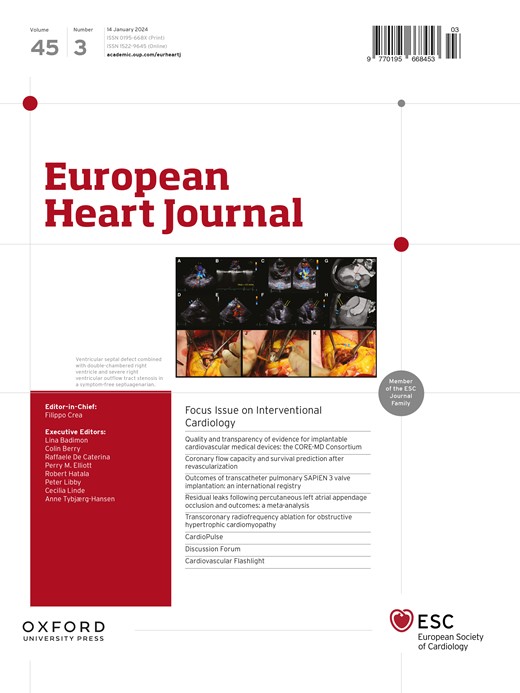Antihypertensive treatment in young adults and cardiovascular risk: a population-based cohort study.
IF 35.6
1区 医学
Q1 CARDIAC & CARDIOVASCULAR SYSTEMS
引用次数: 0
Abstract
BACKGROUND AND AIMS The efficacy of antihypertensive drug treatment in reducing hypertension-related outcomes has been documented in old and middle age but never in younger individuals. The aim of this study was to assess the protective effect of antihypertensive drugs in young adults (18-39 years) by comparing the risk of nonfatal and fatal outcomes in patients with different adherence to antihypertensive drugs. Analysis was extended to middle-aged patients (40-55 years) for comparison. METHODS Using the healthcare utilization database of the Lombardy region (Italy), 286 751 residents, aged 18-55 years, who were newly prescribed antihypertensive drugs between 2009 and 2017 were identified. Adherence to drug therapy was measured by the proportion of the follow-up covered by antihypertensive drug prescription, and data were compared for adherent vs non-adherent patients, i.e. drug coverage ≥ 80% vs <80% of the follow-up duration. The primary outcome was hospital admissions for cardiovascular (CV) events. Secondary outcomes were CV and all-cause death. Cox and the cause-specific hazard regression models were used to estimate hazard ratio (HR) and 95% confidence interval (CI). RESULTS Over a follow-up of about 6 years, the HR of hospitalization for a CV outcome associated with adherence to antihypertensive drugs was 0.78 (95% CI 0.65-0.94) and 0.80 (95% CI 0.76-0.84) among patients aged 18-39 and 40-55 years, respectively. Adherence to antihypertensive drugs was negatively associated with CV and all-cause mortality in the older group (-18%, 6-28%; -30%, 27-33%), while showing no significant effects on these outcomes in the younger one. CONCLUSIONS In a real-life setting, adherence to antihypertensive drug treatment reduced CV risk in young adults as much as in middle-aged patients.青年人抗高血压治疗与心血管风险:一项基于人群的队列研究
背景和目的降压药物治疗在降低中老年高血压相关结局方面的疗效已有文献记载,但在年轻人中从未有过。本研究的目的是通过比较不同抗高血压药物依从性患者的非致命性和致命性结局的风险来评估抗高血压药物对年轻人(18-39岁)的保护作用。分析扩展到中年患者(40-55岁)进行比较。方法利用意大利伦巴第地区医疗保健利用数据库,对2009 - 2017年新开降压药的18-55岁居民286 751人进行分析。通过降压药处方覆盖随访的比例来衡量药物治疗的依从性,并比较依从性和非依从性患者的数据,即药物覆盖率≥80%和<80%的随访时间。主要终点是心血管(CV)事件的住院率。次要结局是CV和全因死亡。采用Cox和病因特异性风险回归模型估计风险比(HR)和95%置信区间(CI)。结果在约6年的随访中,18-39岁和40-55岁患者中,CV结果与抗高血压药物依从性相关的住院风险比分别为0.78 (95% CI 0.65-0.94)和0.80 (95% CI 0.76-0.84)。在老年组中,抗高血压药物依从性与CV和全因死亡率呈负相关(-18%,6-28%;-30%,27-33%),而在年轻组中对这些结果没有显着影响。结论:在现实生活中,坚持抗高血压药物治疗可以降低年轻人和中年患者的心血管风险。
本文章由计算机程序翻译,如有差异,请以英文原文为准。
求助全文
约1分钟内获得全文
求助全文
来源期刊

European Heart Journal
医学-心血管系统
CiteScore
39.30
自引率
6.90%
发文量
3942
审稿时长
1 months
期刊介绍:
The European Heart Journal is a renowned international journal that focuses on cardiovascular medicine. It is published weekly and is the official journal of the European Society of Cardiology. This peer-reviewed journal is committed to publishing high-quality clinical and scientific material pertaining to all aspects of cardiovascular medicine. It covers a diverse range of topics including research findings, technical evaluations, and reviews. Moreover, the journal serves as a platform for the exchange of information and discussions on various aspects of cardiovascular medicine, including educational matters.
In addition to original papers on cardiovascular medicine and surgery, the European Heart Journal also presents reviews, clinical perspectives, ESC Guidelines, and editorial articles that highlight recent advancements in cardiology. Additionally, the journal actively encourages readers to share their thoughts and opinions through correspondence.
 求助内容:
求助内容: 应助结果提醒方式:
应助结果提醒方式:


